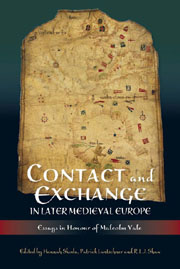Book contents
- Frontmatter
- Contents
- List of Illustrations
- List of Contributors
- Acknowledgements
- The Work of Malcolm Vale
- Principal Bibliography of Malcolm Vale
- Introduction
- Part I Boundaries and Units
- Introduction
- Economic Development, Social Space and Political Power in Bruges, c. 1127–1302
- Flemings in the Peasants' Revolt, 1381
- Does a Common Language Mean a Shared Allegiance? Language, Identity, Geography and their Links with Polities: The Cases of Gascony and Brittany
- Revisiting the Political Uses of Vernacular Language in Portugal during the Thirteenth Century: On Models, Motives and Modes
- Scotland in the Later Middle Ages: A Province or a Foreign Kingdom for the English?
- The Angevin Legacy, Dynastic Rivalry and the Aftermath of the Hundred Years War, 1453–1491
- Part II Practices of Exchange
- Conclusions
- Index
- Tabula Gratulatoria
Introduction
from Part I - Boundaries and Units
Published online by Cambridge University Press: 05 February 2013
- Frontmatter
- Contents
- List of Illustrations
- List of Contributors
- Acknowledgements
- The Work of Malcolm Vale
- Principal Bibliography of Malcolm Vale
- Introduction
- Part I Boundaries and Units
- Introduction
- Economic Development, Social Space and Political Power in Bruges, c. 1127–1302
- Flemings in the Peasants' Revolt, 1381
- Does a Common Language Mean a Shared Allegiance? Language, Identity, Geography and their Links with Polities: The Cases of Gascony and Brittany
- Revisiting the Political Uses of Vernacular Language in Portugal during the Thirteenth Century: On Models, Motives and Modes
- Scotland in the Later Middle Ages: A Province or a Foreign Kingdom for the English?
- The Angevin Legacy, Dynastic Rivalry and the Aftermath of the Hundred Years War, 1453–1491
- Part II Practices of Exchange
- Conclusions
- Index
- Tabula Gratulatoria
Summary
It is obvious that processes of exchange must be shaped and often constrained by the boundaries across which they operate, and it is therefore fitting to open this volume with various explorations of the nature of boundaries and units in the later Middle Ages. The relationship between developing boundaries and units, and processes of exchange, is a reciprocal one: the nature of boundaries was itself moulded by the contacts and exchanges which took place across them. This is true of a variety of different types of contact. In the commercial sphere, Spindler's article demonstrates that perceived boundaries between what it was to be considered English or Flemish respectively were concretised by the presence of Flemings in an alien environment. In the social sphere, Dumolyn's article illustrates how social boundaries were shaped by the fear of too much social interchange. Branco and Pépin both consider the ways in which linguistic influences and identities shored up perceptions of boundaries. Keen demonstrates that political exchange across Channel and political borders actually helped to shape the nature of those boundaries, and engendered far more complex configurations of political networks than the French versus English paradigm we might assume.
The relationship between units and boundaries was indeed especially complex, and potentially highly charged: the possibility of their deliberate manipulation in the interests of political expediency meant that exchange across boundaries was a particularly effective way of making points about social and territorial relationships.
- Type
- Chapter
- Information
- Contact and Exchange in Later Medieval EuropeEssays in Honour of Malcolm Vale, pp. 27 - 32Publisher: Boydell & BrewerPrint publication year: 2012



